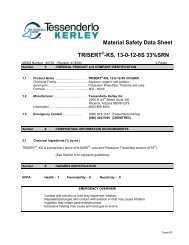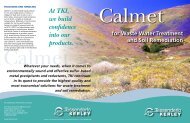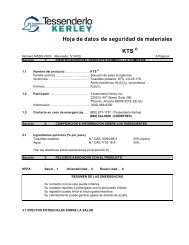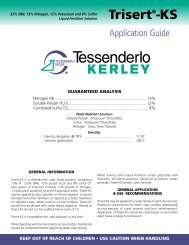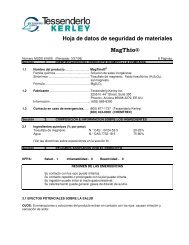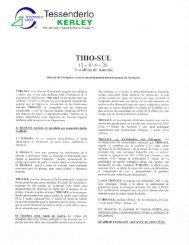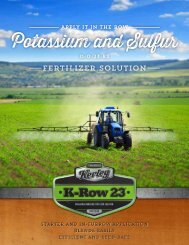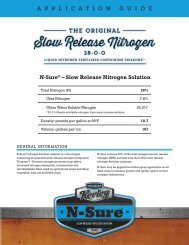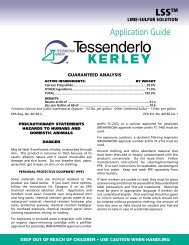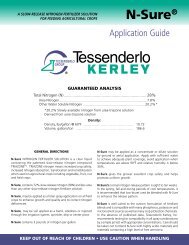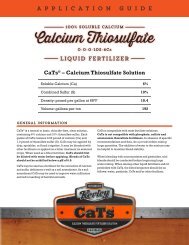Molten Sulfur MSDS - Tessenderlo Kerley
Molten Sulfur MSDS - Tessenderlo Kerley
Molten Sulfur MSDS - Tessenderlo Kerley
Create successful ePaper yourself
Turn your PDF publications into a flip-book with our unique Google optimized e-Paper software.
Material Safety Data Sheet<br />
<strong>Molten</strong> <strong>Sulfur</strong><br />
<strong>MSDS</strong> Number 7000 (Revised: 4/30/02)<br />
Section 1: CHEMICAL PRODUCT and COMPANY IDENTIFICATION<br />
6 Pages<br />
1.1 Product Name ....................................... <strong>Molten</strong> sulfur<br />
Chemical Family .................................... Non-metallic element<br />
Synonyms .............................................. Sulphur, Brimstone, Flowers of sulfur<br />
Formula .................................................. S<br />
1.2 Manufacturer .........................................<strong>Tessenderlo</strong> <strong>Kerley</strong> Inc.<br />
2255 N. 44 th Street, Suite 300<br />
Phoenix, Arizona 85008-3279<br />
Information ............................................ (602) 889-8300<br />
1.3 Emergency Contact ...................... (800) 877-1737 (<strong>Tessenderlo</strong> <strong>Kerley</strong>)<br />
(800) 424-9300 (CHEMTREC)<br />
Section 2: COMPOSITION, INFORMATION ON INGREDIENTS<br />
2.1 Chemical Ingredients (% by wt.)<br />
<strong>Sulfur</strong> CAS #:7704-34-9 >99%<br />
Hydrogen sulfide CAS #:7783-06-4
Page 2.<br />
Section 3: HAZARDS IDENTIFICATION Cont.<br />
3.1 POTENTIAL HEALTH EFFECTS<br />
EYE: Contact with the eyes by product will cause thermal burns to cornea. Eye irritation from exposure to<br />
fumes is possible..<br />
SKIN CONTACT: Contact with product can cause thermal burns (up to third degree).<br />
SKIN ABSORPTION: Absorption is unlikely to occur.<br />
INGESTION: Ingestion of product will cause thermal burns of mouth, throat and stomach.<br />
INHALATION: Inhalation of product vapors can be dangerous. <strong>Sulfur</strong> dioxide (severe respiratory irritant) and<br />
hydrogen sulfide (highly toxic gas) may cause breathing difficulties, loss of sense of smell, dizziness, eye<br />
irritation, loss of consciousness and (potentially) death.<br />
CHRONIC EFFECTS/CARCINOGENICITY:<br />
Not listed as a carcinogen by NTP, IARC or OSHA.<br />
Section 4: FIRST AID MEASURES<br />
4.1 EYES: Immediately flush with large quantities of water for 15 minutes. Hold eyelids apart during irrigation<br />
to insure thorough flushing of the entire area of the eye and lids. Obtain immediate medical attention.<br />
4.2 SKIN: Immediately flush with large quantities of water to dissipate heat. If burns have occurred, cool area<br />
(unless burns are third degree - open wound). Treat for shock if necessary. A thin crust of sulfur may remain<br />
on the skin after material cools. Crust should not be removed except by a physician (it provides a sterile<br />
shield for injured area). Do not attempt to remove sulfur-impregnated clothing as it may adhere to flesh.<br />
Obtain immediate medical attention.<br />
4.3 INGESTION: Not likely to be needed. DO NOT INDUCE VOMITING. If victim is conscious, immediately<br />
give large quantities of water. If vomiting does occur, continue to give fluids. Obtain immediate medical<br />
attention.<br />
4.4 INHALATION: Remove victim from contaminated atmosphere. If breathing is labored, administer oxygen.<br />
If breathing has ceased, clear airway and start mouth to mouth resuscitation. If heart has stopped beating,<br />
external heart massage should be applied. Obtain immediate medical attention.<br />
Section 5: FIRE FIGHTING MEASURES<br />
5.1 FLAMMABLE PROPERTIES<br />
FLASH POINT: 405º F (207º C) METHOD USED: COC<br />
5.2 FLAMMABLE LIMITS H 2 S LFL: 4% UFL: 44%<br />
5.3 EXTINGUISHING MEDIA: Dry chemical, sand, foam, carbon dioxide and water (fog or spray). Cool down<br />
with water and smother with steam, foam or dry chemical.
Page 3<br />
Section 5: FIRE FIGHTING MEASURES (Cont.)<br />
5.4 FIRE & EXPLOSIVE HAZARDS: .When overheated hydrogen sulfide or sulfur dioxide vapors may<br />
evolve. Hydrogen sulfide may form explosive mixtures with air. (See Section 5.2) Keep containers/storage<br />
vessels in fire area cooled with water spray. If the vapors venting from a vessel are burning, they should be<br />
permitted to continue to burn until the source of ignition has been extinguished. Water spray is effective in<br />
“washing” venting vapors from the air.<br />
5.5 FIRE FIGHTING EQUIPMENT: Because of the possible presence of toxic gases and the potential of<br />
thermal burns, wear self-contained breathing apparatus, pressure demand, MSHA/NIOSH (approved or<br />
equivalent) and full protective gear.<br />
Section 6: ACCIDENTAL RELEASE MEASURES<br />
6.1 Small releases: Wear full personal protective equipment. Confine small releases sand, earth or<br />
other inert absorbent. Prevent liquid from entering sewers, watercourses or low lying areas. Keep away from<br />
sources of ignition. Allow confined material to solidify before cleanup. Uncontaminated material may be<br />
reused.<br />
6.2 Large releases: Wear full personal protective equipment. Confine area to qualified personnel. Shut<br />
off release if safe to do so. Dike spill area to prevent runoff into sewers, drains (possible explosive mixtures) or<br />
surface waterways (potential aquatic toxicity). Recover as much of the solution as possible. Treat remaining<br />
material as a small release (above).<br />
Section 7: HANDLING and STORAGE<br />
7.1 Handling: Material is handled at high temperatures; protective clothing is required. Handle in enclosed<br />
containers to avoid breathing product. Avoid any sources of ignition Avoid contact with skin and eyes. Use<br />
in a well ventilated area. Use non-ferrous tools to avoid sparking. Liquid sulfur should not be placed in any<br />
vessel which contains trace quantities of water (potential steam explosion) or hydrocarbons (evolution of<br />
hydrogen sulfide gas). Wash thoroughly after handling.<br />
7.2 Storage: Store in cool, dry, well ventilated areas in enclosed containers. Do not store combustibles in the<br />
area of storage vessels. Keep away from any sources of heat or flame. Keep moisture away from the bottom<br />
of tanks. Electrostatically ground storage and transfer vessels. (See Section 10.4 for materials of<br />
construction)<br />
Section 8: EXPOSURE CONTROLS, PERSONAL PROTECTION<br />
8.1 RESPIRATORY PROTECTION: Wear self-contained breathing apparatus, pressure demand,<br />
MSHA/NIOSH (approved or equivalent).<br />
8.2 SKIN PROTECTION: The use of thermally resistant gloves are recommended. It is recommended that<br />
impervious clothing be worn to prevent direct skin contact.. Wash contaminated clothing and shoes prior to<br />
reuse.<br />
8.3 EYE PROTECTION: Chemical goggles and a full face shield.
Page 4.<br />
Section 8: EXPOSURE CONTROLS, PERSONAL PROTECTION (Cont.)<br />
8.4 EXPOSURE GUIDELINES: OSHA ACGIH<br />
TWA STEL TLV STEL<br />
<strong>Sulfur</strong> dioxide 5 ppm 35 ppm 2 ppm 5 ppm (15 min.)<br />
Hydrogen sulfide 20 ppm (ceiling) 10 ppm (ceiling)<br />
Section 8: EXPOSURE CONTROLS, PERSONAL PROTECTION<br />
8.5 ENGINEERING CONTROLS: Use adequate exhaust ventilation to prevent inhalation of product vapors.<br />
Maintain eyewash/safety shower in areas where chemical is handled.<br />
Section 9: PHYSICAL and CHEMICAL PROPERTIES<br />
9.1 APPEARANCE: Opaque yellow, orange, or tan liquid at high temperatures.<br />
9.2 ODOR: Characteristic pungent odor.<br />
9.3 BOILING POINT: 831° F(444° C)<br />
9.4 VAPOR PRESSURE: 0.1 mm Hg @ 284° F (140° C)<br />
9.5 VAPOR DENSITY: 3.64 at 284º F (140º C)<br />
9.6 SOLUBILITY IN WATER: Insoluble<br />
9.7 SPECIFIC GRAVITY: 1.8 at 266º F (130º C) (15.0 lbs/gal)<br />
9.8 FREEZING POINT: 246º F (119º C) - melting point<br />
9.9 pH: No data<br />
9.10 VOLATILE: Not applicable<br />
Section 10: STABILITY and REACTIVITY<br />
10.1 STABILITY: This is a stable material<br />
10.2 HAZARDOUS POLYMERIZATION: Will not occur.<br />
10.3 HAZARDOUS DECOMPOSITION PRODUCTS: Heating this product may evolve sulfur dioxide and<br />
hydrogen sulfide vapors.<br />
10.4 INCOMPATIBILITY Avoid contact with nitrates, nitrites or chlorates, chlorites, carbon, carbides and<br />
other strong oxidizing agents which can form explosive mixtures. Elemental sulfur can react with metals such<br />
as sodium, calcium, tin, nickel or zinc under certain conditions. Material is corrosive to ferrous and mild steel<br />
materials. All handling and storage equipment should be constructed of stainless steel, aluminum or ploy-type<br />
materials. (SEE Section 7.2, Storage)<br />
Section 11: TOXICOLOGICAL INFORMATION<br />
11.1 ORAL: No data available
Page 5<br />
Section 11: TOXICOLOGICAL INFORMATION (Cont.)<br />
11.2 DERMAL: Data not available<br />
11.3 INHALATION: Data not available<br />
11.4 CHRONIC/CARCINOGENICITY: No evidence available<br />
11.5 TERATOLOGY: Data not available<br />
11.6 REPRODUCTION: Data not available<br />
11.7 MUTAGENICITY: Data not available<br />
Section 12: ECOLOGICAL INFORMATION<br />
10,000 ppm/ 96 Hr./ mosquito fish/ Tl m / fresh water<br />
Section 13: DISPOSAL CONSIDERATIONS<br />
This product does not meet the definition of a hazardous waste in accordance with 40 CFR 261, Subpart C.<br />
Section 14: TRANSPORT INFORMATION<br />
14.1 DOT Shipping Name: <strong>Sulfur</strong>, molten<br />
14.2 DOT Hazard Class: 9 (domestic only)<br />
4.1 (international)<br />
14.3 UN/NA Number: NA2448 (domestic only)<br />
UN2448 (international)<br />
14.4 Packing Group: III<br />
14.5 DOT Placard: Class 9 (domestic only)<br />
Flammable solid (international)<br />
14.6 DOT Label(s): Class 9 (domestic only)<br />
Flammable solid (international)<br />
14.7 IMO Shipping Name: <strong>Sulfur</strong> (molten)<br />
14.8 RQ (Reportable Quantity): NA<br />
14.9 RR STCC Number: 14-716-20
Page 6<br />
Section 15: REGULATORY INFORMATION<br />
15.1 OSHA: This product is listed as a hazardous material under criteria of the Federal<br />
OSHA Hazard Communication Standard, 29 CFR 1910.1200.<br />
15.2 SARA TITLE III: a. EHS (Extremely Hazardous Substance) List: No<br />
b. Section 311/312, (Tier I,II) Categories: Immediate (acute) Yes<br />
Fire<br />
Yes<br />
Sudden release No<br />
Reactivity<br />
Yes<br />
Delayed (chronic) No<br />
c. Section 313 (Toxic Release Reporting-Form R): No<br />
Chemical NameCAS Number<br />
Concentration<br />
d. TPQ (Threshold Planning Quantity): No<br />
15.3 CERCLA/SUPERFUND: RQ (Reportable Quantity) No<br />
15.4 TSCA (Toxic Substance Control Act) Inventory List: Yes<br />
15.5 RCRA (Resource Conservation and Recovery Act) Status: No<br />
15.6 WHMIS (Canada) Hazard Classification: NA<br />
15.7 DOT Hazardous Material: (See Section 14) Yes<br />
15.8 CAA Hazardous Air Pollutant (HAP) No<br />
Section 16: OTHER INFORMATION<br />
REVISIONS:<br />
The entire <strong>MSDS</strong> was reformatted to comply to ANSI Standard Z400.1-<br />
1993, by Technical Services-<strong>Tessenderlo</strong> <strong>Kerley</strong>, Inc.<br />
Address revised 7/13/99<br />
Section 8.3, Eye Protection revised and revised logo, 4/30/02<br />
THE INFORMATION PUBLISHED IN THIS MATERIAL SAFETY DATA SHEET HAS BEEN COMPILED FROM OUR EXPERIENCE<br />
AND OSHA, ANSI, NFPA, DOT, ERG, AND CHRIS. IT IS THE USER’S RESPONSIBILITY TO DETERMINE THE SUITABILITY OF<br />
THIS INFORMATION FOR THE ADOPTION OF NECESSARY SAFETY PRECAUTIONS. WE RESERVE THE RIGHT TO REVISE<br />
MATERIAL SAFETY DATA SHEETS PERIODICALLY AS NEW INFORMATION BECOMES AVAILABLE.



